Govind Ji Temple in Jaipur: Step into a World of Divine Allure
During my recent sojourn in the enchanting city of Jaipur, I had the pleasure of staying at the illustrious Samode Haveli. As fate would have it, a serendipitous morning heritage walk led me to Govind Ji Temple, a place of unparalleled prominence and sanctity in this regal city. This sacred haven not only holds immense religious significance but also stands as a testament to the illustrious history of the Rajasthani rulers. Intrigued by the temple’s allure, I found myself attending the morning aarti, a spiritual ceremony of utmost devotion. To my astonishment, a sea of devotees had congregated, their fervent prayers filling the air with ethereal energy.
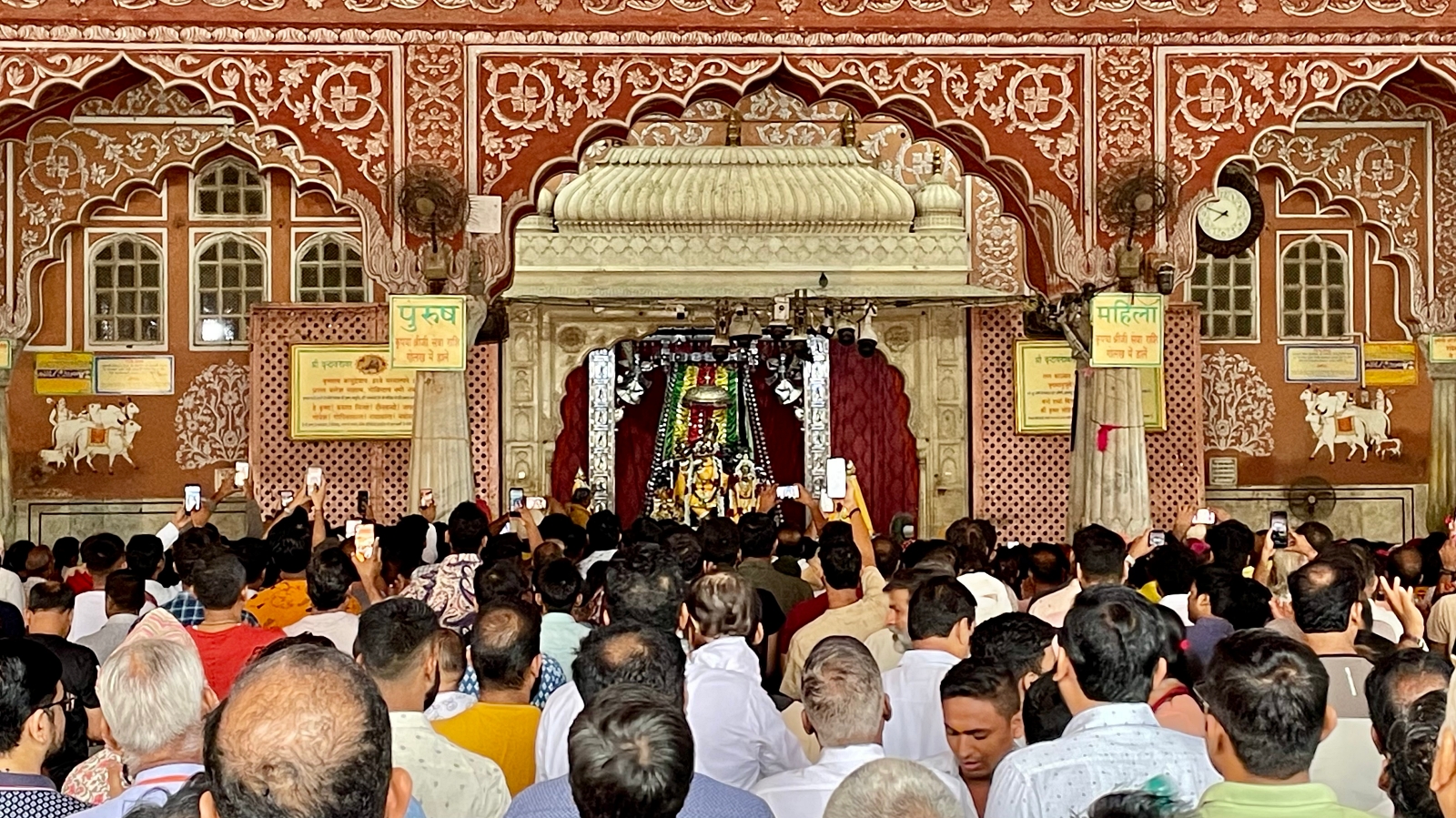
Witnessing this grand spectacle, I was overcome with a profound sense of reverence and awe. It was during this captivating experience that I had the delight of conversing with Yugdeep Singh, the esteemed General Manager of Samode Haveli. With an air of enchantment, he regaled me with tales that revolved around this sacred abode. The temple’s walls seemed to whisper secrets of the past, each story more captivating than the last. I am compelled to share these compelling narratives so that if destiny ever leads you to the vibrant streets of Jaipur, you shall not miss the opportunity to bask in the divine aura of this remarkable temple.
Table of Contents
The Legend of Govind Ji’s Idol
Legend has it that over 5500 years ago, a remarkable tale unfolded. Bajranabh, the great-grandson of Lord Shri Krishna, was a mere thirteen years old when he embarked on a divine mission. Inspired by his grandmother’s vivid descriptions of the Lord’s original appearance, young Bajranabh yearned to create a replica of the deity. With unwavering determination, Bajranabh set to work, meticulously following the instructions passed down through generations. His first attempt yielded an idol with feet that mirrored those of Lord Krishna himself. This extraordinary creation was christened Lord ‘Madan Mohan Ji’ and found its eternal abode in the sacred city of Karauli, Rajasthan.
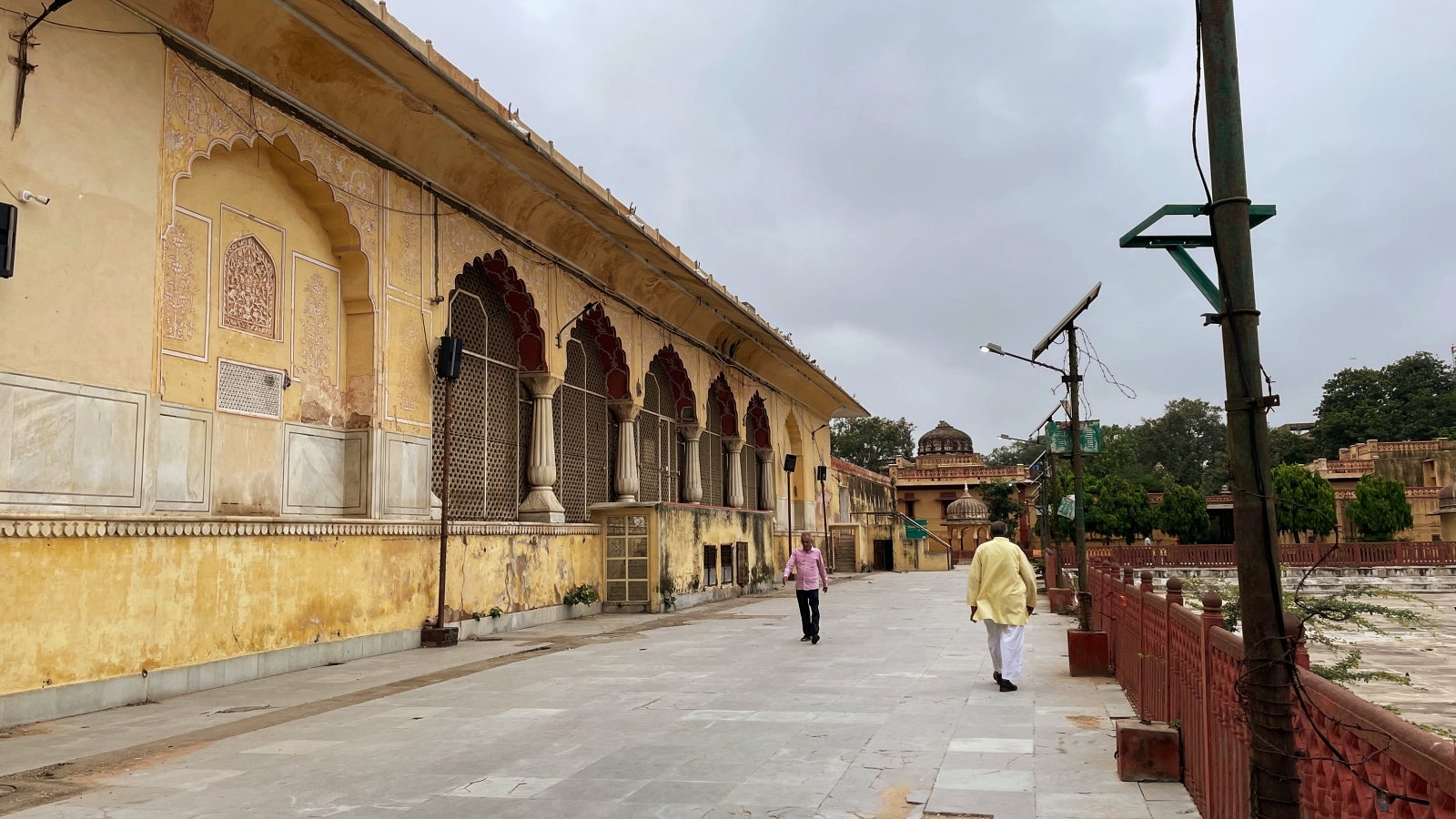
Undeterred by his initial success, Bajranabh’s artistic fervour burned brighter. He crafted a second idol, this time capturing the divine essence of Lord Krishna’s chest. This masterpiece, aptly named Lord ‘Gopi Nath Ji,’ found its sanctuary in the ancient bastion of Purani Basti, Jaipur, Rajasthan. But it was the third and final idol that would forever etch Bajranabh’s name in the annals of history. With painstaking precision, he sculpted an idol that embodied every aspect of Lord Shri Krishna’s divine form. His grandmother, the ultimate authority on the Lord’s appearance, bestowed her approval upon this magnum opus.
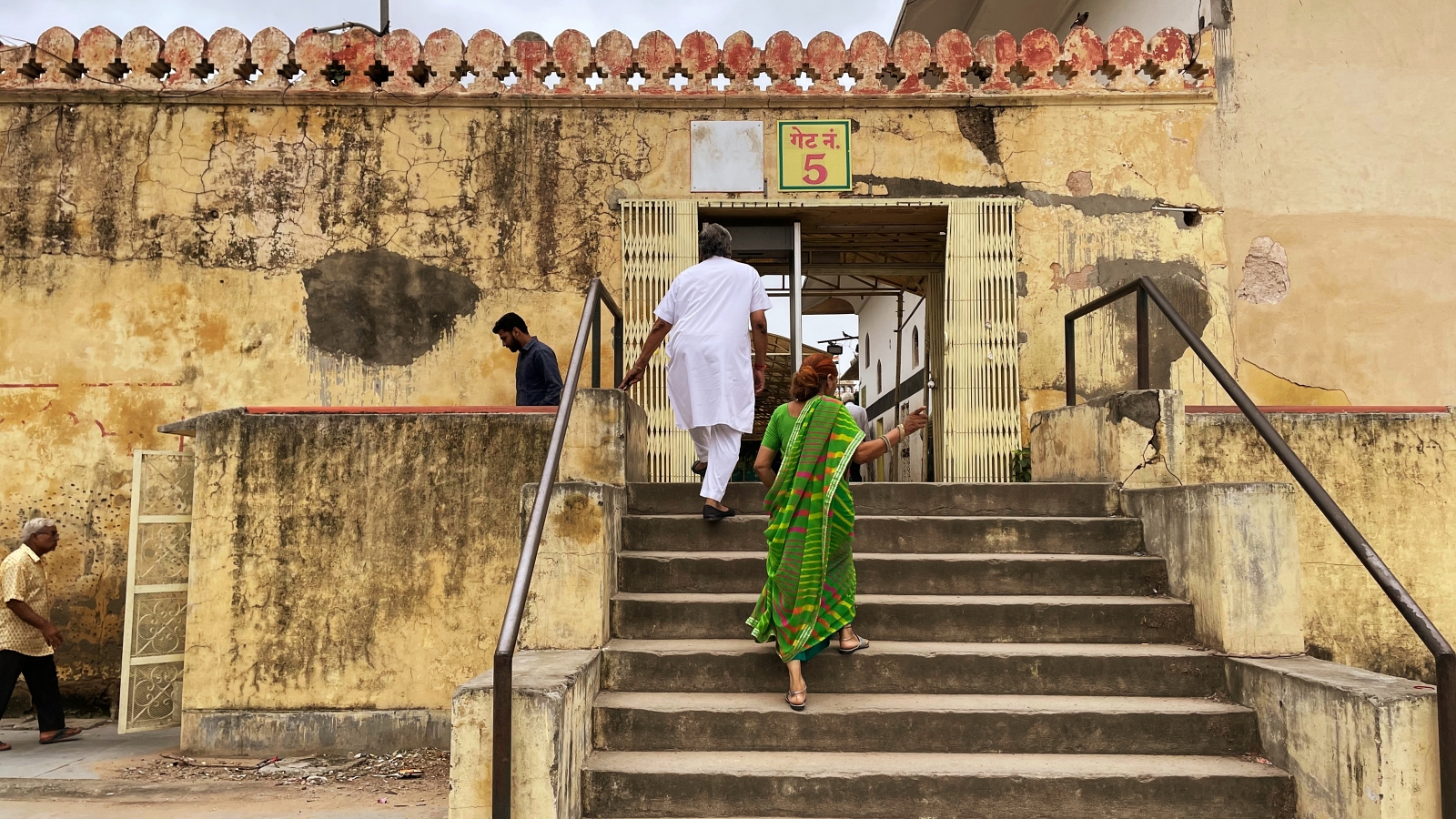
Thus, the world beheld the birth of Lord ‘Govind Ji,’ the epitome of Krishna’s celestial beauty. This extraordinary creation, known as ‘Bajrakrit’ or ‘created by Bajranabh,’ became a beacon of devotion and reverence. The idol of Govind Ji, resplendent in its divine glory, continues to inspire awe and devotion to this day.
The Fascinating Tale of Jaipur’s Govind Dev Ji Temple
This sacred place holds the essence of Lord Krishna’s earthly incarnation, and it reigns as the principal deity of the illustrious Kachwaha Dynasty, rulers of the magnificent Amber/Amer. Legend has it that the idol of Govind Ji bears an uncanny resemblance to the very form of Lord Krishna himself. Such is the divine allure of this idol that even the great Maharaja Sawai Jai Singh, the ruler of Jaipur, was captivated by its divine presence. So deep was his devotion that he meticulously designed his palace, ensuring that he could catch a glimpse of the Lord directly from his regal abode, once the idol was gracefully shifted from Amer to Jaipur.
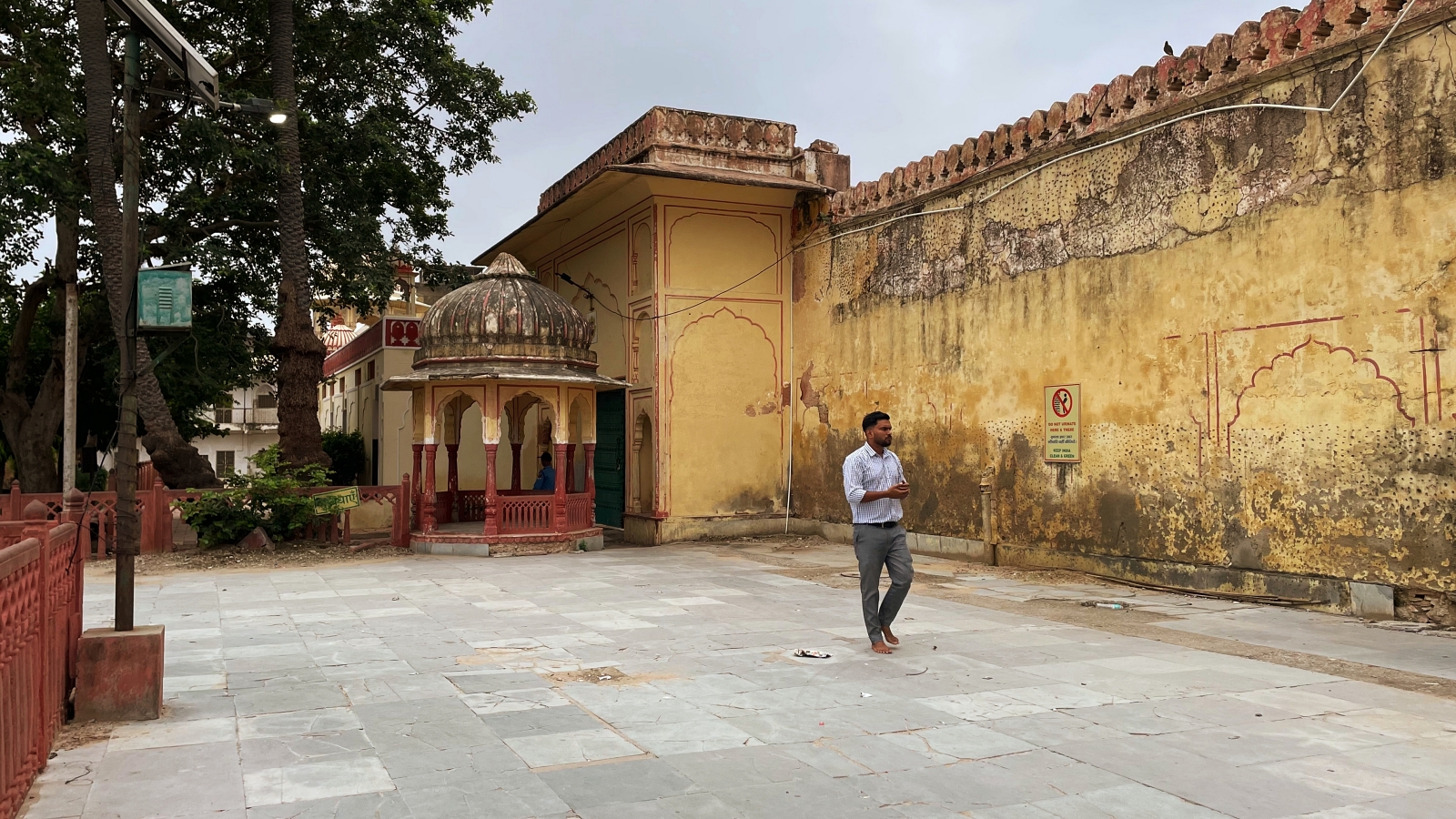
The temple’s grandeur and the legend it holds have made it a magnet for pilgrims, attracting a colossal footfall that reverberates with devotion and reverence. Its significance resonates with the faithful, who seek solace and blessings in the divine aura that permeates every inch of this sacred space. The air seems to hum with the fervent prayers of the faithful, their hopes and dreams intermingling with the incense that wafts through the temple’s corridors. The walls, adorned with intricate carvings and vibrant frescoes, whisper tales of a bygone era, where gods and mortals danced together in a celestial symphony. The temple’s sanctum sanctorum, the holiest of holies, houses the divine idol of Govind Ji.
Temple History
Lord Govind Dev Ji, a manifestation of the mighty Lord Krishna himself is intricately woven into the tapestry of Jaipur’s rich history and the legacy of its illustrious rulers. Legend has it that the original idol of Govind Dev Ji resided in a sacred temple nestled in the mystical lands of Vrindavan. It was a treasure hidden away, waiting to be discovered. And so it was, around four and a half centuries ago, that a devoted disciple of the revered Shri Chaitanya Mahaprabhu, Srila Rupa Goswami, unearthed this divine relic from the sacred Goma Teela in Vrindavan.
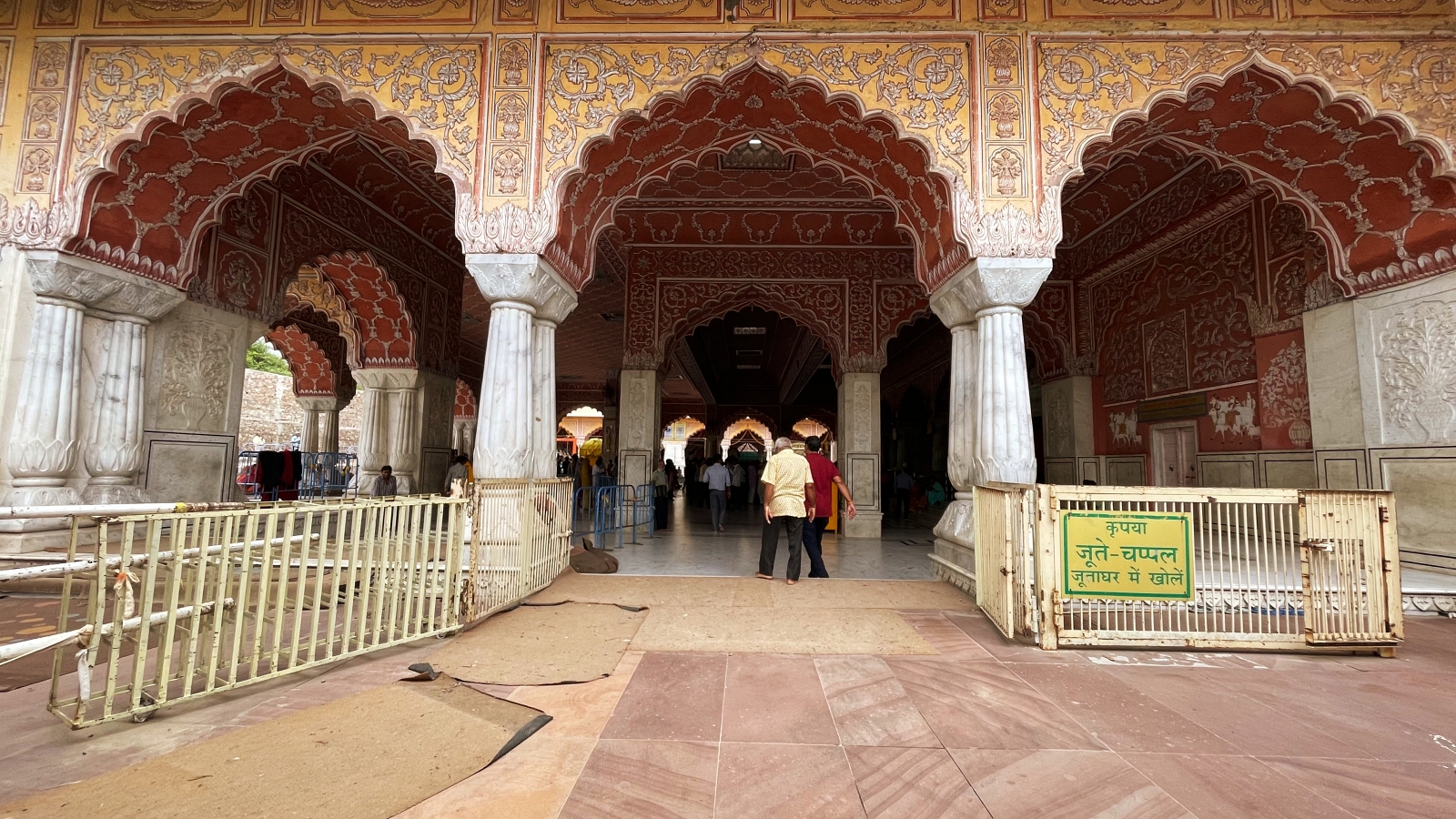
News of this extraordinary find spread like wildfire, reaching the ears of the great Maharaja of Amer, Sawai Man Singh, who was no stranger to the allure of the divine. In a remarkable display of devotion and reverence, he joined forces with the mighty Mughal Emperor Akbar himself. Together, they embarked on a monumental endeavour – the construction of a magnificent temple in Vrindavan, a testament to their unwavering faith. The year was 1590 A.D., and the temple began to take shape. Its grandeur was unparalleled, a sight to behold for generations to come.
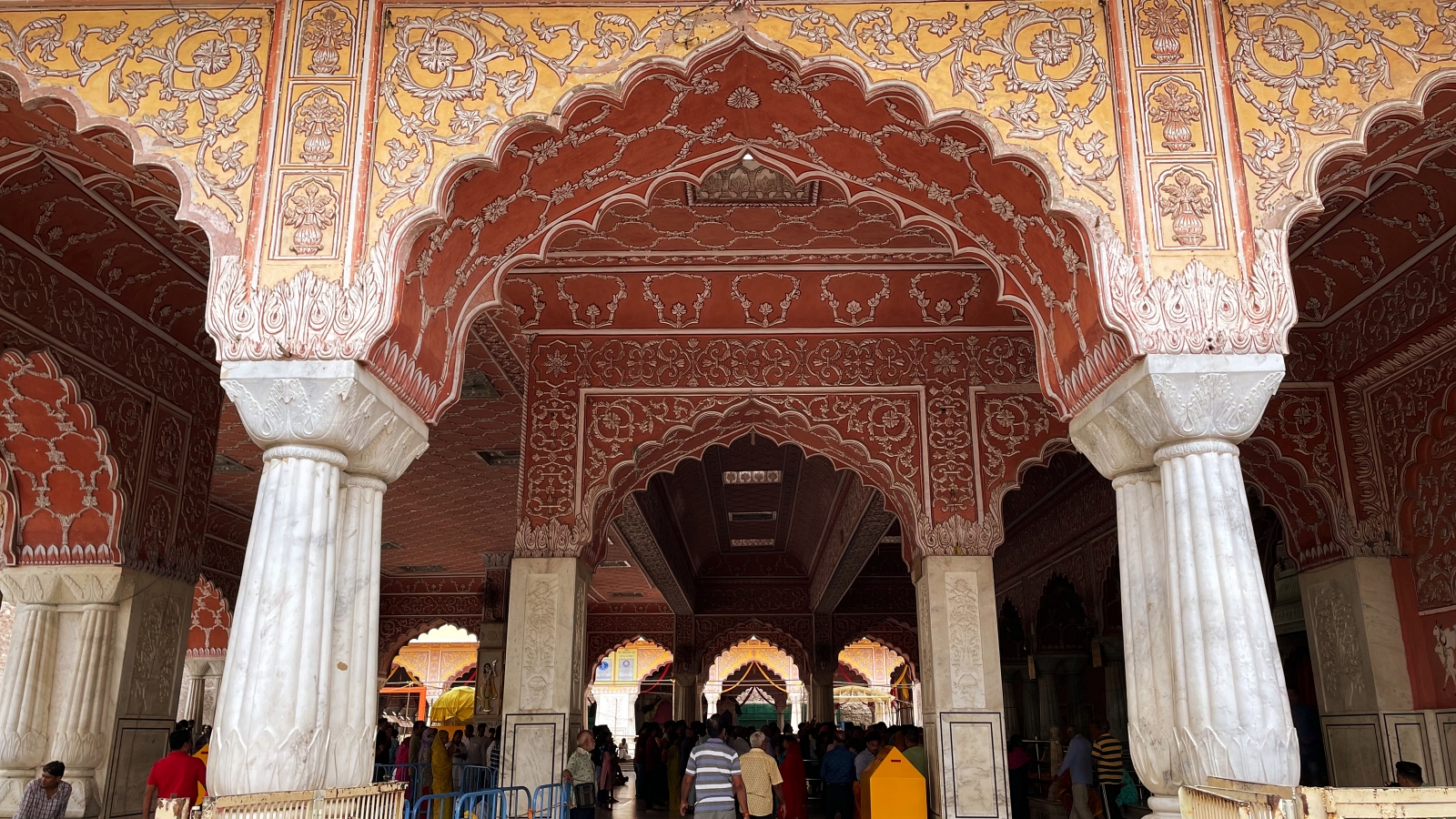
The temple stood as a symbol of the harmonious coexistence of two great empires. In a grand display of generosity, Akbar, the mighty emperor, bestowed upon the temple the red sandstone. Originally intended for the construction of the majestic Agra Fort, this precious material found its purpose in the creation of a temple. But that was not all, for the emperor’s benevolence knew no bounds. He granted a vast expanse of 135 acres of land for livestock and a source of nourishment. Yet, amidst this era of opulence, darkness loomed. The 17th century witnessed the ruthless Aurangzeb, the Mughal ruler, unleashing his wrath upon Hindu temples and their sacred idols.
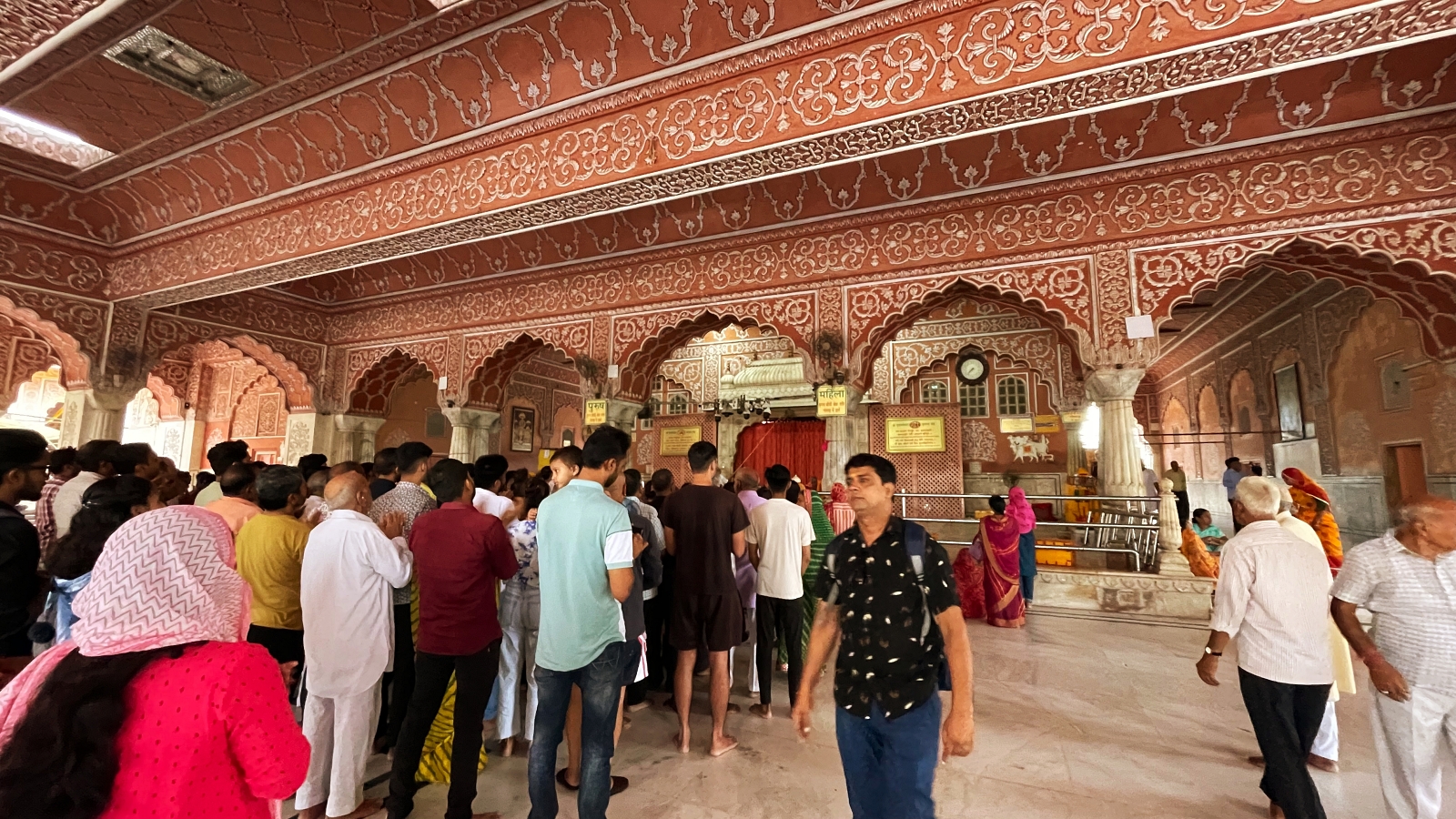
It was during this tumultuous time that the idol of Govind Ji found solace in the care of Shri Shiv Ram Goswami, a guardian of faith in Vrindavan. Driven by an unwavering determination to protect these precious relics, Goswami embarked on a perilous journey. He traversed the lands, tirelessly transferring the idols from Vrindavan to Kama in Bharatpur, then to Radhakund, and finally to Govindpura in Sanganer. Each step taken, each transfer made, was a testament to his unwavering devotion and the lengths he would go to safeguard these sacred symbols of divinity.
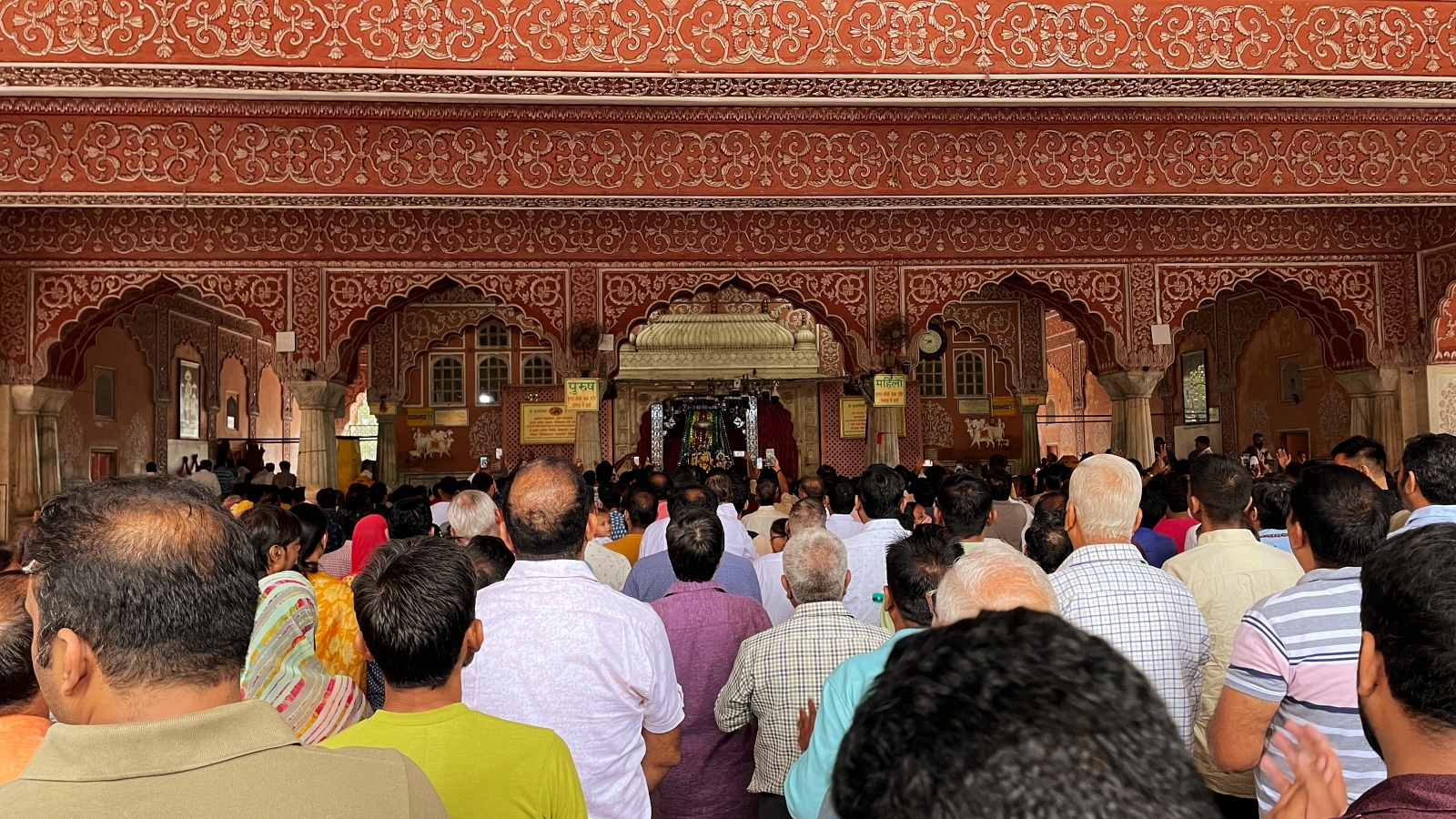
In this dramatic tale of devotion and resilience, the red sandstone stands as a symbol of Akbar’s magnanimity, forever etched in the temple’s walls. And amidst the chaos and destruction, the idol of Govind Ji found refuge, carried across treacherous paths by the unwavering spirit of Shri Shiv Ram Goswami. In a grand display of devotion and responsibility, Maharaja Sawai Jai Singh, the ruler of Amer, took it upon himself to safeguard the revered idol of Lord Govind Dev Ji, the principal deity of the ruling dynasty. Realizing the significance of this divine artefact, he carefully chose the magnificent Amer Valley, which he later christened Kanak Vrindavan in 1714 AD. But, the Maharaja faced a formidable challenge.
The winds of power blew from the Mughal court, and Amer found itself entangled in the intricate web of Mughal politics. The ruler knew that any confrontation with the mighty Mughals could spell disaster for his kingdom. Thus, he made a difficult decision – the idol could not be placed in the open, for it would risk a dangerous standoff with the Mughals. With a heavy heart, the Maharaja concealed the precious deity within the protective confines of Kanak Vrindavan, a hidden sanctuary nestled within the Amer Valley.
The Maharaja understood the profound significance of Lord Govind Dev Ji to his dynasty and the people of Amer. With great courage and foresight, he ensured that the divine idol remained safe, allowing the flame of devotion to burn brightly within the hearts of his subjects. In a grand display of divine intervention, the idol of Govind Ji embarked on a remarkable journey from Amer to Jaipur, forever altering the course of history.
Surya and Chandra Mahal
It was the year 1735 AD when Maharaja Sawai Jai Singh, guided by celestial visions in his dreams, heeded the call of the Lord himself. With unwavering faith and reverence, Maharaja Sawai Jai Singh orchestrated the idol’s majestic arrival at the illustrious Surya Mahal. In his heart, he believed that this magnificent palace rightfully belonged to Lord Govind Ji, and thus, he took the momentous decision to enshrine the deity within its sacred walls. As a testament to his devotion, the Maharaja graciously relocated his own residence to a newly constructed palace, aptly named Chandra Mahal.
The architectural marvel of Chandra Mahal was meticulously designed to ensure that the idol of Govind Ji would be perpetually visible from its regal chambers. As time passed, the Suraj Mahal, once the abode of the sun, underwent a transformation of its own. Renamed and reborn, it emerged as the illustrious Govind Ji Temple, a hallowed sanctuary that would forever bear witness to the Maharaja’s profound devotion and the divine intervention that had brought the idol to its sacred grounds.
Architecture of Govind Dev Ji Temple
Govind Ji Temple stands tall, crafted meticulously from sandstone and marble, its ceilings adorned with a resplendent layer of gold. This architectural marvel is a harmonious fusion of Rajasthani, Muslim, and Classical Indian elements, a testament to the rich cultural tapestry of the land. Nestled beside a regal abode, the temple’s walls are adorned with exquisite chandeliers that cast a mesmerizing glow upon the sacred space.
Paintings, like portals to another world, grace the walls, telling stories of devotion and transcendence. As you step into the temple’s embrace, a verdant oasis unfolds before your eyes. The lush green garden, aptly named ‘Talkatora,’ envelops the temple, offering a sanctuary of serenity. It is a playground of nature’s wonders, where children can frolic and explore to their heart’s content. In this holy shelter, history and spirituality intertwine, creating an atmosphere that transcends time.
Satsang Hall of Govind Ji Temple
The Satsang Hall of Govind Ji Temple stands as a distinguished hermitage, dedicated to the solemn observance of religious and cultural rituals. This sacred space, born from the visionary mind of the esteemed Late Shri Pradhyuman Kumar Goswami Ji, was brought to fruition under the watchful guidance of his son, the illustrious Shri Anjan Kumar Goswami, and his grandson, the venerable Shri Manas Kumar Goswami Ji.
Within the hallowed walls of this divine haven, devotees gather to partake in profound spiritual experiences and immerse themselves in the rich tapestry of cultural traditions. It is here that the essence of faith intertwines with the vibrant threads of heritage, creating an atmosphere that resonates with the echoes of devotion and reverence. Today, as the sun’s golden rays cascade through the stained glass windows, illuminating the hall’s ornate carvings and intricate artwork, one cannot help but be captivated by the ethereal beauty that surrounds them.
The Satsang Hall of Govind Ji Temple has etched its name in the prestigious Guinness Book of World Records, claiming the title of the World’s widest single-span R.C.C. flat roof construction. This architectural marvel spans a staggering 118 feet, a feat that took an awe-inspiring 383 days to complete. The construction process demanded the utilization of a staggering 290 tons of steel and an astounding 2000 cubic meters of concrete.
The Satsang Hall, with its unparalleled width, defies the boundaries of conventional construction, leaving onlookers in a state of utter amazement. In a grand display of devotion, the idol of Govind Ji emerges from the temple’s sacred confines, paraded through the streets during each aarti and the magnificent ‘Rajbhog’ ceremony. Adorned with resplendent silverware, the deity is offered a delectable feast fit for the gods themselves.
Sweets, in all their mouthwatering glory, are lavishly included in the Rajbhog, tantalizing the senses of all who witness this divine spectacle. Adding to the enchantment, both Radha and Krishna idols are adorned in exquisite costumes, each a unique masterpiece, during every aarti. The air crackles with anticipation as the devotees eagerly await this mesmerizing transformation, a visual feast that transports them to a realm of ethereal beauty. But it is the humble laddoo, the sacred prasad of the temple, that truly captures the hearts of the faithful. This simple yet divine offering holds a special place in the hearts of devotees, who can acquire this blessed prasad from the very heart of the temple complex itself.
Timings and Entry Fees
Visiting the temple? No need to break the bank – there’s absolutely zilch, nada, zero entry fee! That’s right, you can explore the wonders of this temple without spending a single penny.
Temple Timings
Temple doors are open to devotees from 4:30 AM to 12:00 PM and 5:45 PM to 9:30 PM during the glorious summer season. And, during the winter chill, they adjust their timings from 5:00 AM to 12:15 PM and 5:00 PM to 8:45 PM. The temple caters to your devotion, no matter the time of year.
Aarti Timings
The aarti timings vary by half an hour to 45 minutes depending on the seasons, be it the scorching summers or the chilly winters. When the mercury rises, the delightful morning Mangla aarti kicks off at the crack of dawn, precisely at 4:30 AM. As the sun climbs higher, the enchanting Dhoop aarti takes place at 7:30 AM, followed by the glamorous Shringar aarti at 9:30 AM.
Best Time to Visit
The Govind Ji Temple is a must-visit mandir throughout the year. But, if you really want to witness a spectacle, mark your calendar for Janmashtami! This extraordinary celebration is a feast for the eyes, where the deities are bedecked in resplendent jewels and adorned with charming clothing. Holi, another major festival, is also a fantastic time to pay a visit to the Govind Ji Temple.
A riot of colours, laughter echoing through the air, and infectious energy will make your heart dance. It’s a celebration that will leave you feeling like a kid again, ready to dive headfirst into a pool of vibrant hues. With its year-round accessibility and these two dazzling festivals, you’ll be left in awe of the divine beauty and joy that permeates this sacred place.
How to Reach Govind Dev Ji Ka Temple
Located within the City Palace premises, the Govind Ji temple is a breeze to reach from any corner of the city. You’ve got options galore when it comes to transportation – hop on a cab, grab an auto-rickshaw, or even pedal your way there on a charming cycle rickshaw. And hey, if you’re feeling adventurous, why not hop on a Rajasthan city bus and make a grand entrance? Just make sure to get off at Sindhi Camp Bus Stop, the closest one to the temple. From there, it’s a piece of cake to hire a cycle rickshaw, auto-rickshaw, or even an e-rickshaw to whisk you away to the palace.
Now, if you happen to be arriving by train, Jaipur Junction Railway Station is your go-to stop. Once you’ve disembarked, simply snag a cab and let it whisk you away to the City Palace. So, whether you’re a fan of four wheels, two wheels, or even no wheels at all, getting to the Govind Ji temple is easily manageable.



